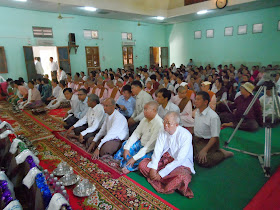 |
| One of the pieces of original artworks that was completed by a meditator and will appear in Shwe Lan |
“They are most beautiful, many of these monasteries—great buildings of dark-brown teak, weather-stained, with two or three roofs one above the other, and at one end a spire tapering up until it ends in a gilded 'tee.' Many of the monasteries are covered with carving along the façades and up the spires, scroll upon scroll of daintiest design, quaint groups of figures here and there, and on the gateways moulded dragons.” Harold Fielding, Soul of a People
Monasteries come in all kinds of different shapes and sizes, from giant concrete complexes with hundreds of monks in attendance to teak kutis built deep in the forests that house only a single occupant. Those monasteries that receive more dana or regularly welcome foreigners are often known to have slightly improved amenities.
Monasteries are not guesthouses. When looking at hotels, it is reasonable to ask about the room, the shower, the bed, and other such living conditions, and to even ask to inspect them before choosing to stay. Monasteries are a place for yogis to develop their nekhemma parami, meaning renunciation and acceptance. By definition, monasteries are places of simple living but where most basic necessities are met, and above this one need not request.
If you have a medical condition or special request, it is appropriate to communicate this to the Sayadaw and politely inquire if the monastery can meet this need. An example would be having a bad back and needing a certain amount of padding when sleeping, or feeling under the weather and needing a quiet place to rest. However, be careful not to stretch the meaning of “special needs.” Needing almond-flavor soymilk instead of 2% or asking the kitchen to prepare separate dishes with fewer chilies may pass at Western meditation centers, but you’ll have to make due here, and anything that does come from a request should be reimbursed to either the office or kitchen staff. In fact, one of the main reasons many Sayadaws hesitate to accept Westerners is they know ahead of time about their propensity to have such “special needs”, and they worry that their basic monastery will not be able to meet their standard of living. For this reason, it is important that the foreign yogi adapt to local conditions as much as possible (while not compromising health), and to show monks that you are satisfied with what has been given and do not require more. Your behavior will impact not only the relations you have with the monastery, but will have consequences for many more yogis who may wish to practice there in the future—if your stay causes any difficulties or complexities then they may hesitate to offer such an opportunity the next time someone comes to request.
On this point, it may be relevant to hear the words of one Dutch monk who has been living in Myanmar for several years: “What I think cannot be stressed enough is that all facilities, food, teachings etc are all gifts, they are coming from the generosity of others. You're a guest in somebody else’s place, [so] you can't demand things as you wouldn't if you are visiting friends. Here at [my monastery], too many times I've seen foreigners forgetting that everything is a gift. They make demands, complain about the food, require things, don't follow rules or don't show gratitude… I find it painful to see this ignorance, and feel bad for donors who see them.”





















